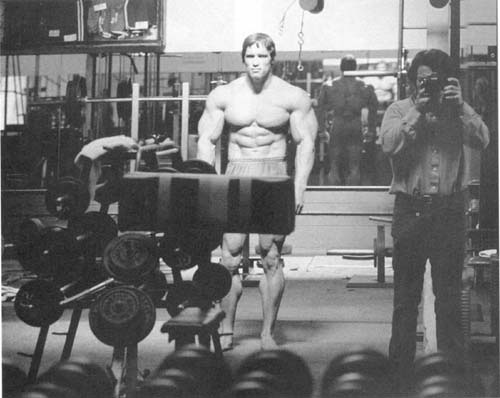Implementing a “training split” is one of the most basic aspects of engaging in an effective fitness routine.
And although there are several different types of splits, the one/s best suited for each individual will depend on several factors like goals, schedule, current level of fitness, routine, etc.
But having a structured routine will allow you to train most optimally for muscle, strength, and function regardless of the activities you’re involved with.
And that’s why following an effectively structured training split ideal. So, we’ve provided several great options that we’re going to talk about.
Let’s begin, shall we…
1. Push/Pull/Legs
Push/pull/legs is a great training split which involves training the pushing muscles one day (chest, shoulder, triceps), the pulling muscles the next (back, biceps, forearms), and lower body (quads, hamstrings, glutes, and calves w/ abs) on the next day.
Rest days will depend on the workout structure.
You can do the training split three days in a row with a rest day in between if you can handle it (not ideal for long-term training progress), or you can do a workout every other day… or, you can even do 2 days on, 1 off, 1 on, then 1 off… repeat.
And you would need to adjust the volume according to which routine you decide to follow.
If you choose to train once per week, the volume (sets/reps) and intensity need to be sufficient to get you through the week. But, if training more than once per week, lower the training volume.
This routine is very effective and efficient and although the benefits are clearly there, the drawbacks also exist.
Benefits
- Maximum focus on primary movers (e.g. chest, back, legs)
- Option to bring up a lagging secondary muscle
- Related muscles trained all at once (e.g. chest, shoulders, triceps) for a synergistic effect.
- More gym time (preference-based)
You can use these workouts to focus heavily on the primary movers, then finish off the secondary muscles since they’ve already been stimulated. Or, you can stimulate the primary mover/s with fewer sets some days, and focus more on the secondary muscles.
And if you enjoy being in the gym, you can opt for 6 days per week training with shorter sessions.
Drawback/s:
- Secondary muscles (e.g. triceps and biceps) are pre-exhausted before isolation exercises. This is not ideal for those who prefer to isolate secondary muscles using maximum weight.
Example workout structure:
- Monday: Chest, shoulders, and triceps
- Tuesday: Back, biceps, and forearms
- Wednesday: Rest
- Thursday: Legs
- Friday: Chest, shoulders, and triceps
- Saturday: Back, biceps, and forearms
- Sunday: Rest
After the rest day on Sunday, the week will start over with the following routine…
Monday you’ll do legs again, then you’ll rest on Tuesday. Wednesday you’ll do another “push” workout, followed by a “pull” workout on Thursday.
So, the pattern will be push, pull, rest, legs… push, pull, rest, legs, and so on.
2-3 exercises and 4 sets per muscle group should be sufficient.
2. 4-Day Split
The 4-day split is one of the most common. And most often, it involves pairing a larger and smaller muscle each day of the training week (e.g. back/bis and chest-tris), and ideally, each workout should utilize at least one compound exercise (e.g. bench press, row, etc).
And there are so many ways to do it. But, it really depends on individual preference, your schedule, and/or your goals.
Here’s a good example of an effective basic 4-day split:
- Monday: Legs
- Tuesday: Active recovery or rest
- Wednesday: Chest and triceps
- Thursday: Back and biceps
- Friday: Rest
- Saturday: Shoulders, arms, and core
- Sunday: Rest
Repeat this split again on Monday.
You would need to adjust your volume to ensure you’re doing enough if training each muscle group once per week. 4-5 exercises with 3 sets per muscle group should be sufficient for once-weekly training.
3. Whole-body Split
Full Body workouts are a great way to train every muscle with compound movements and save time so that you can focus on other endeavors.
But, you’ll also get one heck of an aerobic workout through full-body conditioning.
Compound movements (e.g. bench press, rows, pull-ups, etc) are still the standard for training multiple muscles using a single movement and maximum resistance loads. And you definitely want them to be a staple in your regime.
So, to get the most out of a whole-body split without overtraining, it’s good to use compound movements and focus on high-intensity training. And an isolation exercise per each muscle on top of that won’t hurt either.
But volume should be lower than if you were to train each muscle group once per week due to the higher frequency training.
And depending on whether you’ll train twice or three times per week will ultimately determine how much volume you should be doing. However, there’s no one-size-fits-all formula to determine the amount of volume each person should do.
Now, as far as training schedule, a popular way to do a full-body split would be to workout Monday; rest Tuesday and Wednesday; train Thursday; rest Friday and Saturday; then train Sunday again, for example.
Or, if you train twice per week then take 3-4 days rest for the main muscle groups in between and focus on other body parts (forearms, core, calves), and/or other physical activity.
Now, one study found through testing that doing high frequency, low volume training (3 times per week) elicits similar results to low frequency, higher volume training (once per week) for mass and strength gains over an 8-week period. (1)
But the low-frequency training group performed 3 sets per muscle group three times per week; while the high-frequency training group performed all 9 sets for the target muscle once per week.
This tells us that similar training volume (sets) regardless of frequency yields similar gains.
However, a different study from the Journal of Strength and Conditioning Research found that higher frequency whole-body training may elicit a better hypertrophic effect compared to low-frequency training. (2)
But since muscle hypertrophy is dose-dependent where training volume is concerned, training more frequently can allow for progressively more volume each session. (3, 4)
Example workout structure:
- Monday: Full body
- Tuesday: Active recovery or rest
- Wednesday: Rest
- Thursday: Full body
- Friday: Active recovery or rest
- Saturday: Rest
- Sunday: Full body
When the week starts over again (Monday) following the last workout that was performed on Sunday, do active recovery or rest on Monday and Tuesday.
Then repeat the cycle by doing a workout on Wednesday, and continue this pattern resting two days in between each workout.
4. Specialized Programs
There are a countless number of training programs out there whether they focus on strength, hypertrophy, or both. But, these programs are designed to combine movements in order to achieve a specific desired outcome.
For instance, the 5×5 strength program consists of two workouts which are alternated every other day using compound movements only…
Workout A: Squat, Bench Press, Barbell Row
Workout B: Squat, Overhead Press, Deadlift
There are, of course, many other variables associated with this program. But it’s a simple routine that works all muscle groups and builds progressive strength.
And many of the top-notch specialized programs work very well because of the strategy that goes into creating them.
Check out the 5×5 program details here.
5. Upper/Lower Split
This split is pretty self-explanatory. One day you train your upper body muscles and the next is lower body.
Splitting your body in half (not literally) is actually a very efficient way to train. You won’t have to be in the gym every day and you can maximize compound movements to hit all the muscles of the upper and lower body each workout.
But, you will need to use at least one compound movement for each large muscle group; which will also target the smaller, secondary muscles and this is where the efficiency of training occurs.
Isolating each muscle group without the compound exercises would be very time consuming and it’s not conducive to optimal overload; which is necessary for maximum strength and hypertrophy progress.
But you can indeed implement these types of workout after you’ve sufficiently utilized days where you train with enough intensity using heavier, multi-joint movements.
Here’s an example routine:
- Monday: Lower body
- Tuesday: Upper body
- Wednesday: Core and active recovery
- Thursday: Lower body
- Friday: Upper body
- Saturday: Core and active recovery
- Sunday: Rest
Repeat the routine on Monday.
You can include core training with either day or on its own as shown.
And, of course, you can modify the routine if you prefer to train once per week or even if you prefer to have a rest day in between each session.
But twice-weekly training is ideal for hypertrophy gains according to more recent findings since you can implement a little more volume over additional training days. (4)
6. 5-Day Split (Back, Chest, Legs, Shoulders and Arms, Core and Forearms, and Two Rest days)
If you’re the type who likes being in the gym several days per week and/or you prefer training each muscle group by itself once per week (higher volume), then you’ll really like this split.
Now, there are a few points you should know about this type of training routine if you want the most benefit…
- Incorporate lighter training days/weeks
- Use higher volume (sets/reps) to ensure you’re encouraging sufficient muscle stimulus for the week.
- Focus on compound and isolation exercises to thoroughly train each muscle group.
Designate at least an hour for each individual, primary mover since you’re training them once per week.
And since hypertrophy is more dose-dependent, you’ll need to progressively utilize more training volume through sets/reps, and/or decreased rest times.
But… to an extent. And that’s why a time limit is necessary to ensure you don’t overdo it.
You want to be sure that you’re creating a progressive stimulus, especially since you’re training each muscle group once per week.
And because you’re solely targeting each primary mover, you can implement more isolation movements to finish off after you’ve put sufficient effort into the compound exercises.
But you want to make sure you’re not overtraining due to the higher volume workouts. And to ensure you avoid this occurrence; get your workout in and then get out. Make sure you’re eating sufficient nutrients, drink plenty of water, and get your zzz’s.
Otherwise, prolonged training can have harsh side effects. (5)
And yes, there’s a dose-response relationship when it comes to training volume, but there’s also a limit for each individual.
Here’s an example workout structure:
- Monday: Back
- Tuesday: Chest
- Wednesday: Rest
- Thursday: Legs
- Friday: Shoulders and arms
- Saturday: Rest
- Sunday: Core and forearms
Repeat the split on Monday.
4-5 exercises and 3-4 sets per muscle is a good routine to follow for the 5-day split.
7. Power/Strength And Hypertrophy
Some utilize this split to get the best of both power/strength and hypertrophy benefits. And it’s definitely more conducive for people involved in competitive disciplines (e.g. powerlifting, bodybuilding, CrossFit, etc).
The power days consist of heavy, low rep training and the hypertrophy days focus on purely muscle-building using moderate to higher rep ranges to promote intentional muscle tension.
But the good thing is that both training methods carry over into the other. For example, strength training builds muscle, and hypertrophy training yields strength gains.
But with hypertrophy type training where reps are in the 8-12+ range, you want to intentionally increase the time under tension; which breaks down the muscle tissue and causes a hormone response necessary for hypertrophy. (6)
And according to the New Zealand Institute of Health and Fitness, 30-60 seconds of time under tension is ideal for muscle hypertrophy.
Plus, training with maximal loads all the time is not good for the joints long-term.
Here’s an example workout structure:
- Monday: Upper body power
- Tuesday: Lower body power
- Wednesday: Active recovery
- Thursday: Active recovery
- Friday: Upper body hypertrophy
- Saturday: Lower body hypertrophy
- Sunday: Rest
Repeat on Monday.
Remember, the power/strength days are for heavier loads (3-5 reps) and the hypertrophy days should consist of moderate to higher repetitions (6-20 reps).

Progressing With A Split Routine
The only way to continue making muscle, strength, and performance gains is to continually progress, whether that’s increasing the weight load, and/or training volume, decreasing rest times, implementing new training strategies, etc.
But rest, recovery, and diet are also essential components for making continued progress. And even switching training programs can be beneficial sometimes.
But the more experienced you become in your training, the better you’ll be able to detect when and what sort of changes need to be implemented.
And we have plenty of information to continually help you get to where you need to be.
Check out these 8 training techniques and methods to keep the muscle growth coming…
Wrapping Up
And there you have it… 7 great training splits that are sure to pack on the muscle and strength gains in a reasonable amount of time.
Progress is key to getting results and you can jump from one split to the other after you’ve benefited from one and/or hit a plateau.
But, of course, you’ll have to change up the variables (volume, frequency, etc) to get the most out of your training, as with any other fitness routine.
Plus, your goals, current level of fitness, and schedule will also determine which split is best suited for you.
Every good routine has a structured training split of some sort but you just have to find yours and stick with it!











